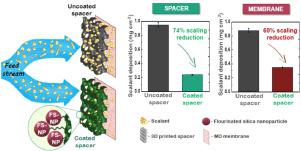Water Research ( IF 11.4 ) Pub Date : 2020-11-16 , DOI: 10.1016/j.watres.2020.116649 Navya Thomas , Mahendra Kumar , Giovanni Palmisano , Rashid K. Abu Al-Rub , Reham Y. Alnuaimi , Emad Alhseinat , Reza Rowshan , Hassan A. Arafat

|
Surface modification of feed spacers rather than membranes may hold more merit as an antiscaling strategy in membrane distillation (MD), as it avoids compromising the functionality of MD membrane. In this work, an antiscaling polyamide 3D printed spacer was developed for MD. The surface of the printed spacer was coated with fluorinated silica (FS) nanoparticles synthesized via a sol-gel process. The sol-gel approach used to synthesize the FS nanoparticles is considered a convenient and easy approach for engineering the spacer's surface structure and roughness. The performance of the FS coated printed surface was evaluated against other coating materials of different chemical properties. The coated surfaces were characterized using water contact angle measurements, ATR-FTIR, Raman, FESEM-EDX, atomic force and 3D microscopes. The 3D printed surface's microscale roughness and hydrophobicity increased, while its surface-free energy decreased with FS nanoparticles coating. The antiscaling performance of uncoated and FS coated spacers was then assessed in a direct contact MD process, using a scale-inducing aqueous solution of calcium sulfate as its feed. The scalant (Ca2+) attachment on the FS coated spacer was 0.24 mg cm−2, 74% lower than on the uncoated 3D spacer (0.95 mg cm−2). Also, by using the antiscaling FS coated spacer, scaling on the membrane surface dropped by 60%. The predominant factors that helped minimize scaling with FS coating were microscale roughness-induced hydrophobicity and reduced surface-free energy that weakened the scalant 's interaction with the spacer surface.
中文翻译:

通过方便的纳米颗粒涂层对膜蒸馏进行防垢3D打印的进料垫片
进料垫片而不是膜的表面改性在膜蒸馏(MD)中作为防垢策略可能具有更多优点,因为它可以避免损害MD膜的功能。在这项工作中,为MD开发了一种防垢聚酰胺3D打印垫片。印刷的垫片的表面涂有氟化硅(FS)纳米颗粒,该纳米颗粒通过溶胶-凝胶过程。用于合成FS纳米粒子的溶胶-凝胶方法被认为是对间隔物的表面结构和粗糙度进行工程设计的便捷方法。相对于其他化学性质不同的涂料,评估了FS涂布的印刷表面的性能。使用水接触角测量,ATR-FTIR,拉曼,FESEM-EDX,原子力和3D显微镜对涂层表面进行表征。3D打印表面的微米级粗糙度和疏水性增加,而其表面自由能随FS纳米颗粒涂层而降低。然后,使用硫酸钙的引发水垢的水溶液作为直接进料,在直接接触MD工艺中评估未涂布和FS涂布的垫片的防垢性能。结垢剂(Ca 2+)在FS涂覆的间隔物上的附着为0.24mg cm -2,比未涂覆的3D间隔物(0.95mg cm -2)低74%。同样,通过使用防垢的FS涂层垫片,膜表面的垢减少了60%。有助于最小化FS涂层结垢的主要因素是微尺度粗糙度引起的疏水性和减少的表面自由能,削弱了结垢剂与垫片表面的相互作用。











































 京公网安备 11010802027423号
京公网安备 11010802027423号